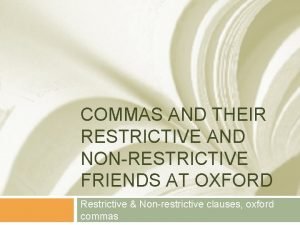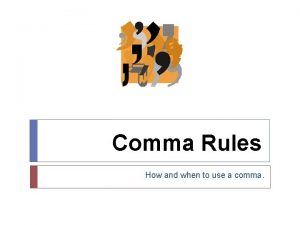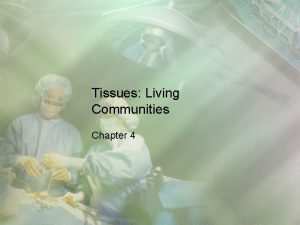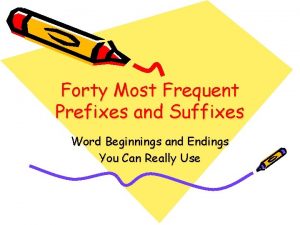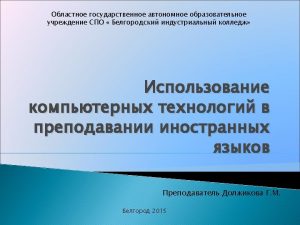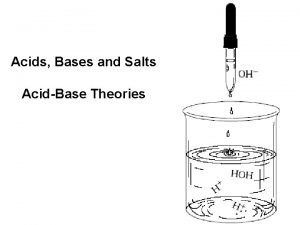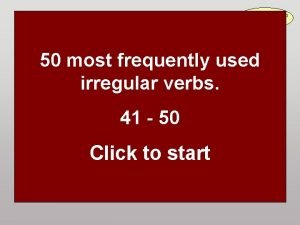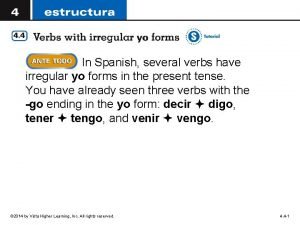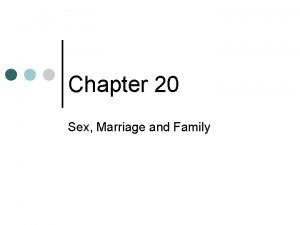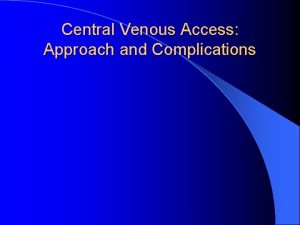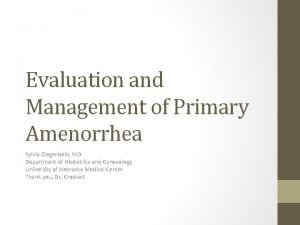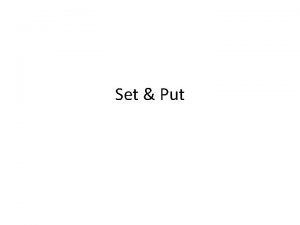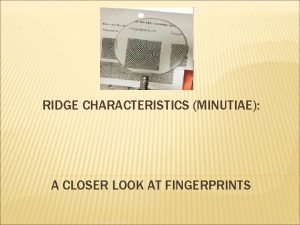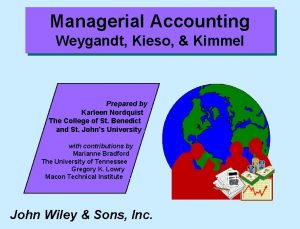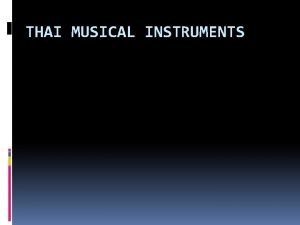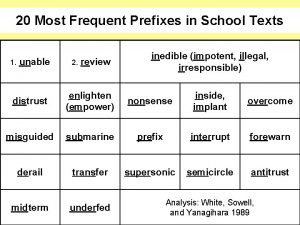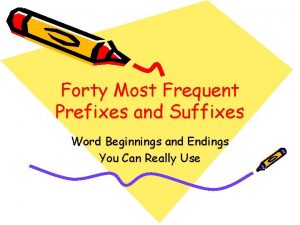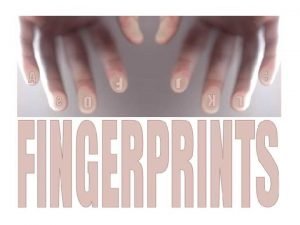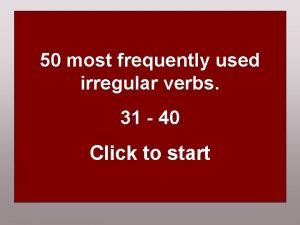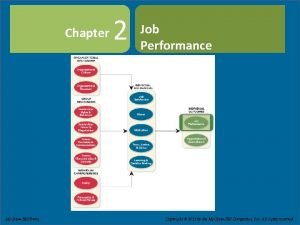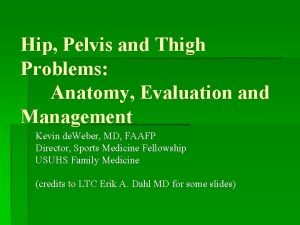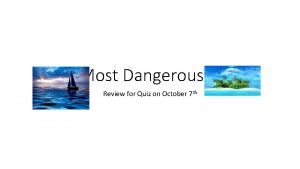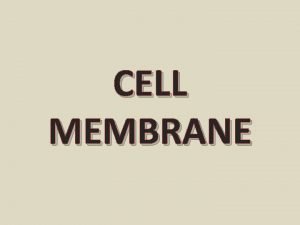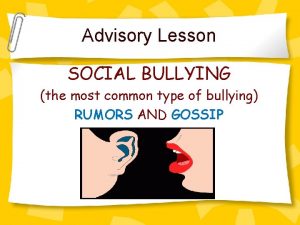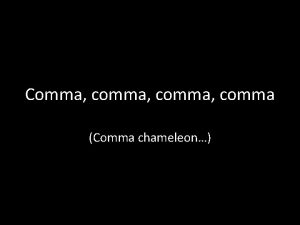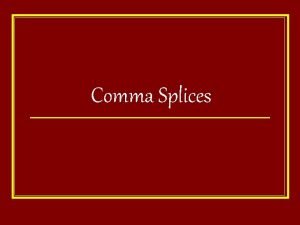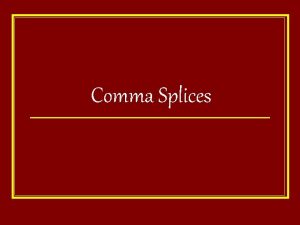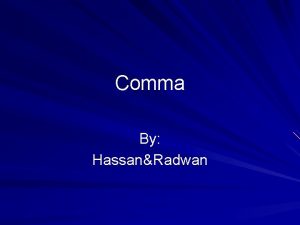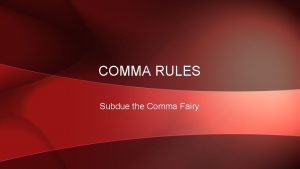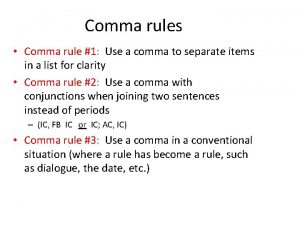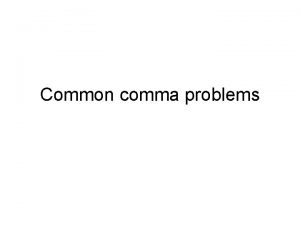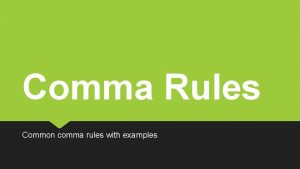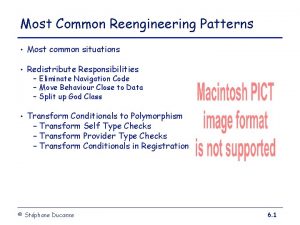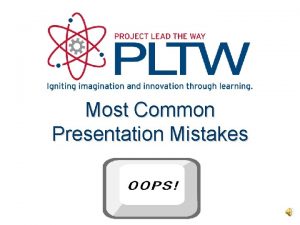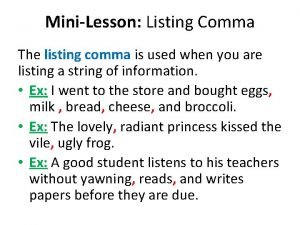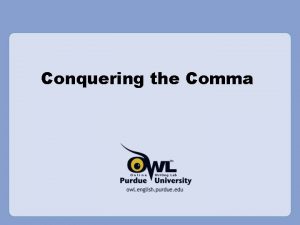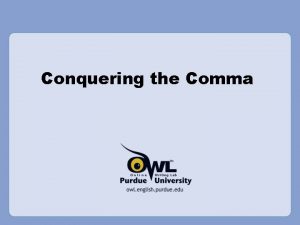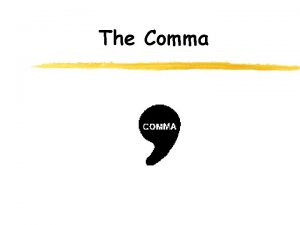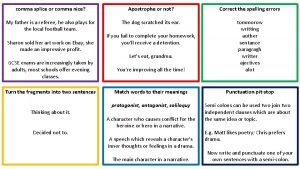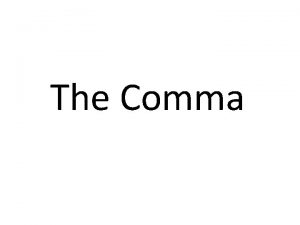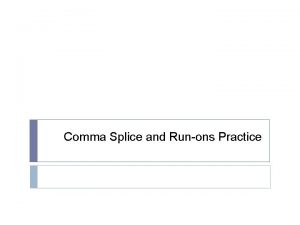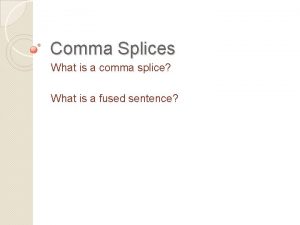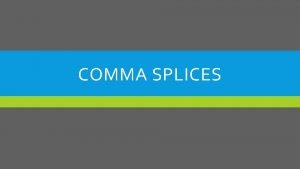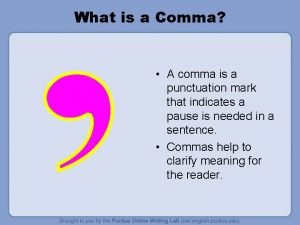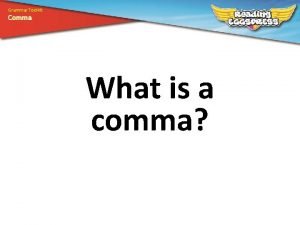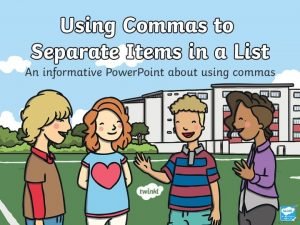THE COMMON COMMA The comma is the most












































- Slides: 44

THE COMMON COMMA

The comma is the most over-used and under-used punctuation mark. If you are not sure how to use a comma, don’t use it. And when you use a comma, use it with caution.

This presentation will discuss the eleven most common uses of the comma. First we will present a list of the eleven common uses. A brief quiz and writing assignments will follow some of the sections. Then we will go into some detail about each of the uses.

The 11 Most Common Uses for the Common Comma , , , , , ,

1. Use a comma to separate a dependent clause from an independent clause.

1. Use a comma to separate a dependent clause from an independent clause. 2. Commas are used after an introductory element.

1. 2. 3. Use a comma to separate a dependent clause from an independent clause. Commas are used after an introductory element. Commas are always used between two complete ideas when they are joined by a coordinating conjunction. Words like: and, but, for, so, yet or nor. Put the comma BEFORE the joining word.

1. 2. 3. 4. Use a comma to separate a dependent clause from an independent clause. Commas are used after an introductory element. Commas are always used between two complete ideas when they are joined by a coordinating conjunction. Words like: and, but, for, so, yet or nor. Put the comma BEFORE the joining word. Use commas to separate parenthetical elements - information not essential to the sentence meaning. Commas are used before and after words that may interrupt a flow of thought

1. 2. 3. 4. 5. Use a comma to separate a dependent clause from an independent clause. Commas are used after an introductory element. Commas are always used between two complete ideas when they are joined by a coordinating conjunction. Words like: and, but, for, so, yet or nor. Put the comma BEFORE the joining word. Use commas to separate parenthetical elements - information not essential to the sentence meaning. Commas are used before and after words that may interrupt a flow of thought Commas must be used to separate three or more items in a series. The comma before the word AND at the end of the list is optional.

1. 2. 3. 4. 5. 6. Use a comma to separate a dependent clause from an independent clause. Commas are used after an introductory element. Commas are always used between two complete ideas when they are joined by a coordinating conjunction. Words like: and, but, for, so, yet or nor. Put the comma BEFORE the joining word. Use commas to separate parenthetical elements - information not essential to the sentence meaning. Commas are used before and after words that may interrupt a flow of thought Commas must be used to separate three or more items in a series. The comma before the word AND at the end of the list is optional. Never use only one comma between a subject and verb.

1. 2. 3. 4. 5. 6. 7. Use a comma to separate a dependent clause from an independent clause. Commas are used after an introductory element. Commas are always used between two complete ideas when they are joined by a coordinating conjunction. Words like: and, but, for, so, yet or nor. Put the comma BEFORE the joining word. Use commas to separate parenthetical elements - information not essential to the sentence meaning. Commas are used before and after words that may interrupt a flow of thought Commas must be used to separate three or more items in a series. The comma before the word AND at the end of the list is optional. Never use only one comma between a subject and verb. Use commas with direct quotations marks. Commas set off the quotations from the rest of the sentence.

1. 2. 3. 4. 5. 6. 7. 8. Use a comma to separate a dependent clause from an independent clause. Commas are used after an introductory element. Commas are always used between two complete ideas when they are joined by a coordinating conjunction. Words like: and, but, for, so, yet or nor. Put the comma BEFORE the joining word. Use commas to separate parenthetical elements - information not essential to the sentence meaning. Commas are used before and after words that may interrupt a flow of thought Commas must be used to separate three or more items in a series. The comma before the word AND at the end of the list is optional. Never use only one comma between a subject and verb. Use commas with direct quotations marks. Commas set off the quotations from the rest of the sentence. Use commas for short expressions such as well, yes, so or oh.

1. 2. 3. 4. 5. 6. 7. 8. 9. Use a comma to separate a dependent clause from an independent clause. Commas are used after an introductory element. Commas are always used between two complete ideas when they are joined by a coordinating conjunction. Words like: and, but, for, so, yet or nor. Put the comma BEFORE the joining word. Use commas to separate parenthetical elements - information not essential to the sentence meaning. Commas are used before and after words that may interrupt a flow of thought Commas must be used to separate three or more items in a series. The comma before the word AND at the end of the list is optional. Never use only one comma between a subject and verb. Use commas with direct quotations marks. Commas set off the quotations from the rest of the sentence. Use commas for short expressions such as well, yes, so or oh. Use a comma when addressing a person to set off a name.

1. 2. 3. Use a comma to separate a dependent clause from an independent clause. Commas are used after an introductory element. Commas are always used between two complete ideas when they are joined by a coordinating conjunction. Words like: and, but, for, so, yet or nor. Put the comma BEFORE the joining word. 4. Use commas to separate parenthetical elements - information not essential to the sentence meaning. Commas are used before and after words that may interrupt a flow of thought 5. Commas must be used to separate three or more items in a series. The comma before the word AND at the end of the list is optional. 6. Never use only one comma between a subject and verb. 7. Use commas with direct quotations marks. Commas set off the quotations from the rest of the sentence. 8. Use commas for short expressions such as well, yes, so or oh. 9. Use a comma when addressing a person to set off a name. 10. Use a comma in addresses and dates.

1. 2. 3. Use a comma to separate a dependent clause from an independent clause. Commas are used after an introductory element. Commas are always used between two complete ideas when they are joined by a coordinating conjunction. Words like: and, but, for, so, yet or nor. Put the comma BEFORE the joining word. 4. Use commas to separate parenthetical elements - information not essential to the sentence meaning. Commas are used before and after words that may interrupt a flow of thought 5. Commas must be used to separate three or more items in a series. The comma before the word AND at the end of the list is optional. 6. Never use only one comma between a subject and verb. 7. Use commas with direct quotations marks. Commas set off the quotations from the rest of the sentence. 8. Use commas for short expressions such as well, yes, so or oh. 9. Use a comma when addressing a person to set off a name. 10. Use a comma in addresses and dates. 11. Use commas when writing an informal letter after the opening and closing.

The 11 Most Common Uses for the Common Comma 1. 2. 3. Use a comma to separate a dependent clause from an independent clause. Commas are used after an introductory element. Commas are always used between two complete ideas when they are joined by a coordinating conjunction. Words like: and, but, for, so, yet or nor. Put the comma BEFORE the joining word. 4. Use commas to separate parenthetical elements - information not essential to the sentence meaning. Commas are used before and after words that may interrupt a flow of thought 5. Commas must be used to separate three or more items in a series. The comma before the word AND at the end of the list is optional. 6. Never use only one comma between a subject and verb. 7. Use commas with direct quotations marks. Commas set off the quotations from the rest of the sentence. 8. Use commas for short expressions such as well, yes, so or oh. 9. Use a comma when addressing a person to set off a name. 10. Use a comma in addresses and dates. 11. Use commas when writing an informal letter after the opening and closing.

Commas are used to separate a dependent clause from an independent clause. What are independent and dependent clauses? Before we discuss what dependent and independent clauses are, we need to define what a complete sentence is. A complete sentence must have a subject and a verb and must express a complete thought. A complete sentence is also called an Independent clause. It is independent, and can stand alone. I walk to the store. That is an independent clause. It is a complete sentence, and it can stand alone. A dependent clause is an incomplete sentence and cannot stand alone. It is a fragment. It can have a subject and a verb but it does not have a complete thought. When I see Tim. That has a subject and a verb, but it does not express a complete thought.

? QUIZ 1 ? Indicate whether each of the sentences are independent or dependent clauses. 1. 2. 3. 4. 5. If the heat doesn’t let up. I always do my homework after dinner. When I have a million dollars. Because she was disruptive. I enjoy going to a movie on a hot day.

Complete sentence = Independent Clause Incomplete sentence = Dependent Clause Sentences often contain independent and dependent clauses. If a dependent clause appears at the start of the sentence, it gets a comma before the independent clause begins. Dependent clause Independent clause If the boys do not behave, they will not be able to play video games. Dependent clause Independent clause When Sandy dances, all the boys watch her. Dependent clause Independent clause While the girls were singing, Sam was serving drinks. Before the program started, there was a speech.

LLL Let’s have a quick review about what we’ve just learned Independent clauses express a complete thought. Dependent clauses express an incomplete thought WWhen an independent clause comes at the start of a sentence, it gets a comma at the end of the clause.

? QUIZ 2 ? Put one line under the dependent clause and two lines under the independent clause. Place a comma in the appropriate position. 1. When the light were put out all the children went to bed. 2. If the party were held on Saturday night more of her friends would have attended. 3. Since I broke my leg I have not been able to mountain bike. 4. Harry gets all A’s in his classes since he started working with a tutor. 5. While she was working with her father she learned to use the computer.

Commas are used after an introductory element. Introductory elements introduce a sentence. An introductory element can be a clause (as was discussed in the last slides) or a phrase that come before the main clause or the independent clause in a sentence. It can be a dependent clause. Introductory clause (dependent clause) (Independent clause) When she danced, her blue eyes lit up. Introductory clause (dependent clause) (Independent clause) If the boys attend the game, they will each get a basket ball.

Introductory elements introduce a sentence. An introductory element can be a phrase. A phrase is a group of words that do not have a subject or a verb, like a propositional phrase. Prepositional phrase Independent clause. In the school yard, the children played quietly. Prepositional phrase Independent clause. At the last session, On Saturday, we talked about the benefits of cats as pets. the mechanic will work on my car.

Don’t put a comma, however, after the main clause when a dependent clause follows. . Independent clause Dependent clause I was frightened when the alarm sounded in the middle of the night. Independent clause Dependent clause Wendy loved the coat before it was torn. Independent clause Dependent clause Cats and dogs get along if they a brought up together. Independent clause Dependent clause The alarm sounds when there is too much smoke in the kitchen.

? QUIZ 3 ? Place a comma – if necessary - in the appropriate places in the sentences below. 1. In the movie theater the people next to us didn’t stop talking. 2. After the dinner was eaten the speakers walked up on the stage. 3. Robin was very excited when she was selected the head of the committee. 4. On the road they met some very interesting people. 5. When the sky darkened they all went into the house. 6. In the meantime I will have to see my doctor.

Commas are always used between two complete ideas – two independent clauses - when they are joined by a coordinating conjunction. Conjunctions are joiners. Coordinating conjunctions join together two independent clauses. Remember, an independent clause can stand alone as a complete thought. The coordinating conjunctions are - for, and, nor, but, or, yet, so. A way to remember the coordinating junctions is with the acronym or word FANBOYS. (F – for, A- and, N- nor, B- but, O- or, Y- yet, S – so. )

The comma goes before the coordinating conjunction. • • • I always take vitamin C twice a day, for it stops me from getting a cold. Will is too tall for the team, and Neil is too short. Lilly will not buy that book, nor will she read any books by that author. The dogs like to go out, but the cats like to stay home. Sam will take out the trash, or he will be punished.

Use commas to separate parenthetical elements - information not essential to the sentence meaning. Use a pair of commas in the middle of a sentence to set off clauses, phrases, and words that are not essential to the meaning of the sentence. Parenthetical Element That Tuesday, which happens to be my birthday, is the only day we can meet. - which happens to be my birthday – is a non-essential element and the sentence will make sense without it. Use one comma to indicate the beginning and one comma to indicate the end of the parenthetical element. A question you need to ask yourself is if you leave out the parenthetical elements will the sentence make sense.

? QUIZ 4 ? This quiz deals with coordinating conjunctions and parenthetical elements. Place commas in the appropriate places in each of the sentences. 1. Tim walked to school but Shelly took the bus. 2. The kitchen was painted yellow and the bathroom was painted green. 3. I was late for the concert so I went to a movie instead. 4. Sam didn’t catch any fish for he forgot to bring his bait. 5. Wendy who wasn’t very pretty always attended the fashion shows. 6. The house which was sold last year appears in a horror movie.

5 Commas must be used to separate three or more items in a series. A series can be words or a groups of words. , Kelly had to replace the dishes the cups bowls after the storm. , , , , the glasses and the Mike likes to eat peaches apples pears and strawberries. , Leroy goes to the cleaners to the grocery store to the bakery and to the hardware store. Continued

The Comma before the word “and” is optional. , , , Mike likes to eat peaches apples pears and strawberries. , Leroy goes to the cleaners to the grocery store to the bakery and to the hardware store. , Kelly had to replace the dishes the cups storm. , , the glasses and the bowls after the Today, however, the comma before AND is usually left out.

Never use only ONE comma between a subject of the sentence and the verb. The subject of a sentence is the thing or the person the sentence is about. First remind me, what is the subject of a sentence? For example: John takes night classes at the local college. John is the subject of the sentence. He is what the sentence is about. The car is in the shop. The car is the subject of the sentence. It is what the sentence is about.

Now, remind me. What is a verb? Verbs show action or state of being. State of being means what something is. John takes night classes at the local college. Takes shows action. It is a verb. The car is in the shop. Is is a state of being. It is a verb.

? QUIZ 5 ? Place commas where they should be. Not all sentences need commas. 1. 2. 3. 4. 5. 6. 7. The store was located on the street where she lived. Harry Mark Sam and Jose were the boys singled out. The book is on the desk. I went to the grocery story the cleaners and the hardware store today. He talked to the teacher about the grade. I have lived in New York Los Angeles and Boston. Dogs cats and birds are favorite pets.

7 Use commas with direct quotations marks* around the exact words spoken and use commas to set off the quotations from the rest of the sentence. , John said without emotion “I will see you tomorrow. ” , , “I was able ” she answered “to complete the assignment. “When I go ” Nell repeated “you will all go. ” *Quotation marks are used to indicate that someone is speaking.

8 Use a comma when addressing a person to set off a name. I am fine, Tom Mary, how are you? Clint, those are very cool sunglasses. . Yours are cool too, Laura.

9 Use commas for short expressions such as well, yes, so or oh. Yes, you will. “Oh, you think you are so terrific. No, I won’t. Well, I have accomplished a lot.

Oh, you make me so angry. Well, I did it again. In the example below, two short expressions “wow” and “yes” are set off by commas. Also, commas are used to set off the names of the people addressed, James and Michael. click Wow, is that your car, James? Yes, it is, Michael.

? QUIZ 6 ? Place commas in the appropriate places. 1. 2. 3. 4. 5. 6. 7. 8. 9. 10. Wendy repeated “I will not attend today’s meeting. ” Wow that is some dress you are wearing. Jose when will you go to the restaurant? Oh I forgot to do my homework. Suzy did you get the fruits I asked you to buy. No I did not. Students I have an import message from the principal. Yes she paid her rent this month. He said “Wait for me in the car. ” “All the boys are in the pool” shouted Maureen.

10 Use a comma in addresses and dates. When a date is written as month followed by a year, a comma separates the day from the year. December 5, 1940. The comma is necessary because of the consecutive numbers. Compare December 5 1940 to the one with the comma. Commas are used to separate geographical references, such as city and state (Dallas, Texas) or city and country (Kampala, Uganda).

11 Use commas when writing an informal letter after the opening and closing. Dear Raymond, I hope you can come to the party Saturday night. Sincerely, Judith Continued

Dear Raymond, I hope you can come to the party Saturday night Sincerely, Judith Mary, r u ok? I’ll cu l 8 tr 2 nite. U have a g 8 wkend w/o him. HAND, Ralph Notice there are commas after the opening, after the name of the person being addressed (Raymond), and there is another one after the closing (Sincerely), before the name of the sender.

? QUIZ 7 ? Write a paragraph of at least ten sentences. Include in your paragraph at least 10 examples of the commas that were discussed in this presentation. Vary your sentences and vary the commas that your use. With you tutor, explain why you have used each of your commas.

 Comma comma comma chameleon meme
Comma comma comma chameleon meme Basic comma rules
Basic comma rules Find the common multiples of 12 and 18
Find the common multiples of 12 and 18 Factors of 60 and 48
Factors of 60 and 48 Common anode and common cathode
Common anode and common cathode Highest common factors and lowest common multiples
Highest common factors and lowest common multiples Common factors and common multiples
Common factors and common multiples Lowest common factor
Lowest common factor What is this called
What is this called Different method of size separation of
Different method of size separation of Prefix of frequent
Prefix of frequent Among the most common meters
Among the most common meters Acid base indicators table
Acid base indicators table People who work with computers while doing business
People who work with computers while doing business The most common form of securing channels is through.
The most common form of securing channels is through. 50 most irregular verbs
50 most irregular verbs Dr shabani
Dr shabani Dr swade endocrinologist
Dr swade endocrinologist Give 9 most common parts of a securement system
Give 9 most common parts of a securement system 50 most common irregular verbs in spanish
50 most common irregular verbs in spanish Around the world, the most common residence pattern is
Around the world, the most common residence pattern is What is scratching method in welding
What is scratching method in welding Data entry in gis
Data entry in gis Most common complication of central venous catheter
Most common complication of central venous catheter The most common type of plant fiber is
The most common type of plant fiber is Small, rounded white puffs. isolated or in long rows.
Small, rounded white puffs. isolated or in long rows. Amenorrhea symptoms
Amenorrhea symptoms Put up with phrasal verb meaning
Put up with phrasal verb meaning What are ridge characteristics?
What are ridge characteristics? The most common budget period is
The most common budget period is Piphat instruments pictures with names
Piphat instruments pictures with names Most popular religion in italy
Most popular religion in italy Salivary gland tumor
Salivary gland tumor Uni di tri tetra
Uni di tri tetra Most common prefixes
Most common prefixes What is the most common crime in india
What is the most common crime in india Computer network threats
Computer network threats What are the common ridge characteristics of a fingerprint
What are the common ridge characteristics of a fingerprint 50 most common irregular verbs in italian
50 most common irregular verbs in italian Employee behaviors that intentionally hinder organizations
Employee behaviors that intentionally hinder organizations Most common hip fracture
Most common hip fracture The most dangerous game quiz
The most dangerous game quiz What does structure fits function mean
What does structure fits function mean The most common type of bullying
The most common type of bullying What is the most common and powerful agent of erosion?
What is the most common and powerful agent of erosion?
